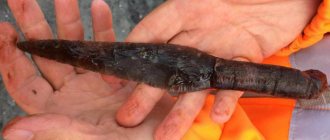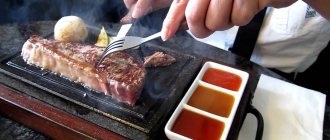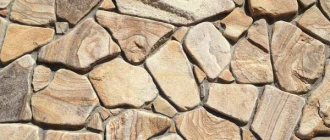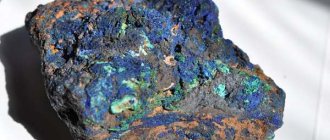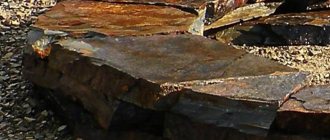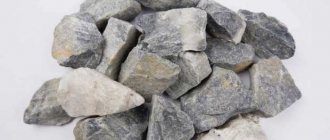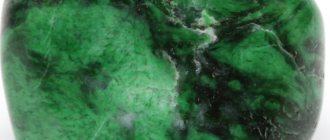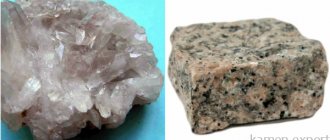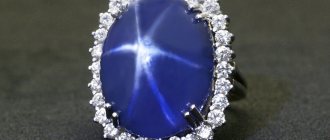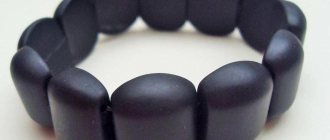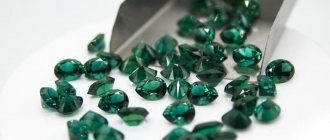Granite is a rock of a certain mineralogical composition that was formed from magma at great depths. This is the most common igneous rock, found on all continents. Thanks to the uplift of large sections of the earth's crust, granite massifs appeared on the surface, which made it possible to study them in detail. Let's look at some brief information about granite, its composition, varieties, and use.
What is granite
Translated from Latin - grain. Natural granite is formed in nature over millions of years. There are 2 known types of origin of the stone:
- Volcanic. The frozen lava of a volcano cools down and acquires a rocky structure. Over many years, granite stone crystallizes in it in the form of grains of different sizes. The process of turning sand into granite takes place along the same path.
- Granitization. During the tectonic displacement of continental plates, different rocks moved deeper into the earth. High temperatures and pressures coupled with chemicals caused granitization.
It contains rocks:
- potassium feldspar;
- quartz;
- mica;
- acidic plagioclase;
- amphibole.
Sometimes additional components are found (pyroxene, graphite, talc and others).
In percentage terms, granite consists of minerals:
- 60–65% – feldspars;
- 25–30% – quartz;
- 5–10% – dark flowers.
It turns out that granite is a mixture, not a pure substance.
It has a crystalline granular structure with crystals of large (more than 5 mm), medium (up to 2–5 mm) and small (up to 2 mm) sizes. There may be small empty cavities inside the stone (microlite granite) or cavities filled with other minerals (cellular or drusy granite).
View this post on Instagram
Posted by Travertine, Granite, Glue Almaty (@airo_group) Jun 20, 2021 at 10:00 PDT
Granite: is it a mineral or rock
Granite is a mountainous mineral rock with a complex composition. This is what geologists, mineralogists, and geographers will say.
For them, it is a mineral; for everyone else, it is a stone, symbolizing durability, strength, and steadfastness.
To say that a mineral has a rich history is not enough. He himself is history: so many ancient and modern monuments of world culture were created from him.
And the famous phrase “gnawing the granite of science” means stubbornly overcoming solid knowledge that has been accumulated by people’s experience.
Interesting facts about granite concern everything connected with it: the origin of its crystals in nature, qualities, types of granite. This will be discussed further.
Types and colors of stone
The different components that make up the stone, as well as their concentration, determine a wide range of color options. The most famous is gray (light or dark gray shades). Other shades:
- pink;
- lilac;
- orange;
- yellow;
- red;
- blue;
- blue;
- green;
- beige;
- brown;
- white;
- black.
Black gabbro granite has a special texture. When processed, you can get a perfectly smooth shiny surface. Granite stone has various patterns - spots, inclusions, striped-wavy patterns, rings.
Geochemical classification of the White and Chappell granitoids
Types of stone in terms of geochemical aspects:
- S – product of melting of metasedimentary rocks;
- I – the result of melting of metamagma substrates;
- M – formed from magmas containing tholeiitic and basaltic rocks;
- A – consists of incoherent chemical elements.
Classification by grain structure
Based on grain structure, they are distinguished:
- Porphyritic. There are protruding long inserts of quartz, microcline, and orthoclase.
- Pegmatoid. A uniformly grained stone with a symmetrical arrangement of grains.
- Rapakivi. Finnish granite stone. It has red round inserts with a gray frame.
- Gneissic. A classic specimen characterized by a fine-grained texture.
Names of stones based on mineral composition
According to mineral composition:
- Alaskite – dark-colored minerals are absent.
- Leucogranite – there are few dark colors.
- Biotite – the content of this mineral in the stone reaches 6–8%.
- Double-mica granite contains both biotite and muscovite.
- Lithium fluoride – the composition contains lithium mica.
- Alkaline – a large percentage of alkaline compounds.
- Pyroxene – content of orthoclase, quartz, augite.
Main varieties
Currently, all mined granite is classified according to several main characteristics: structural and textural parameters, place of extraction (deposit), and so on. Thus, according to the content of dark-colored components, the following types of granites are distinguished :
Leucocratic, or leucogranite, characterized by a reduced concentration of dark-colored components.- Alaska. The structure of this type does not contain dark-colored inclusions at all.
- Double mica. Mineral containing muscovite and biotite.
- Biotite. The level of biotite content varies between 6.0-8.0%.
- Hornblende-biotite (hornblende) variety of stone. It received such a strange name due to the presence of hornblende with biotite in the structure (simply hornblende).
- Lithium fluoride. Characterized by the presence of certain varieties of lithium micas, for example, protolithionite or zinnwaldite.
- Alkaline. A species containing orthoclase, alkaline amphiboles, myrocline or albite, aegirine.
- Pyroxene. A rare species consisting of quartz, orthoclase and augite.
History and origin of the breed
Data on the existence and use of granite in construction have appeared since the times of the countries of the Ancient World: Rome, Egypt, India. For the first time in 1596, the name was mentioned in science in the work of Caesalpinus “De metallicis”. In his work, the Italian naturalist used the Latin word “granum”, which means grain, as a basis.
Due to its strength, reliability, and durability, geologists have called granite the calling card of the Earth.
View this post on Instagram
Posted by Natalya (@natali_kravchenko_) Apr 7, 2021 at 3:17 PDT
Artificial or natural
Despite widespread mining, the properties and uses of natural granite do not always satisfy the goals of the end consumer.
And price is not always the deciding factor. Although she is not small. Artificial granite successfully solves problems that are difficult for natural granite. Products made from it look amazing.
It is difficult to call a stone unnatural: consisting of 80% natural granite chips, it is even outwardly indistinguishable from natural stone.
The characteristics of artificial granite differ little from the characteristics of natural stone. But the price differs noticeably.
The main advantage is the ability to form almost any shape specified by human imagination, because granite is formed from a viscous mass.
Its properties are somewhat inferior to the natural mineral. But a lot depends on the quality of the components and the integrity of the manufacturer.
It is sometimes difficult to distinguish between materials created by nature and man-made. There is only one characteristic of granite that will help you do this. Tap the surface with a metal object: if it is natural, the sound will be loud, and if not, it will be muffled.
Place of Birth
It occurs in the form of batholiths - huge massifs with a large area. Sometimes it occurs in layers, alternating with other rocks.
Mined on all continents. There are large deposits in Somalia, Ethiopia, Namibia, USA, Italy, Germany, Finland, Great Britain, France (Pink Granite Coast).
In former USSR countries:
- Mokryanskoye field in Zaporozhye region (Ukraine);
- Malokokhnovskoye field in Poltava region (Ukraine);
- Mikashevichi in the Brest region (Belarus);
- Kordai district (Kazakhstan).
In Russia, granite deposits have been found in Karelia (Dymovsky, Kashina Gora granite, Letnerechensky, Ladoga, Serdobolsky), Eastern Siberia, the Urals (Kamenogorsky, Malyginsky, Rezhevsky, Sukhovyazsky, Malyshevsky), the Caucasus, the Far East, Bashkiria (Mansurovsky granite, Tashmurunsky deposit ), Central Russia (Pavlovskoye field).
Many types of stone are named after the deposits where they are mined. For example, red representatives extracted from deposits of the same name: Leznikovsky, Mezhdurechensky, Simonovsky, Emelyanovsky, Tokovsky, Kapustinsky. Gray specimens: Korninsky, Sofievsky, Zhezhelevsky, Pokostovsky.
Not only Russian granite is of good quality, but also Chinese, Indian, Brazilian, Ukrainian (Yantsevsky, Tansky, Vasilyevsky, Korninsky).
To watch a video of how the extraction of useful minerals occurs:
Cracks in granites
Granite massifs are often broken by cracks filled with quartz or calcite. Quartz contains minerals of iron, tungsten, and native gold. If the cracks are large and contain a lot of metals, they are developed as deposits.
Rice. 2. Quartz with gold.
Stone processing
The stone is very durable. You can split granite stone with a hammer, cleaver, or sledgehammer. You can break the stone into two parts, split it into several large parts, knock off some parts (shards) or trim it, giving it the desired shape, creating edges - smooth surfaces (faceted granite).
During processing, diamond drills are used for cutting and grinding. It is easy to give the source the desired shape using a tesque. Sometimes heat treatment is required. Heat-treated granite has a rough surface. Bush hammered granite also has such a surface. The essence of the treatment is the shock-rotational effect of special sprockets made of hard alloys.
On the map, the symbol for granite is crosses (pluses) in a frame.
Also watch the program about processing:
Pegmatites
Granitic magma contains many different gases. If the magma chamber cooled for a very long time, the granite body will have a heterogeneous structure. The closer to the central part, the larger the mineral grains. Gradually, gases are pushed inside, where a cavity is formed. Regular crystals of colorless, violet or smoky quartz, beryl, tourmaline, and topaz grow in the cavity from hot gases. Interesting: Sometimes regular intergrowths of quartz and feldspar are formed, which in cross-section look like ancient cuneiform - written granite.
Rice. 3. Written granite.
How to distinguish natural granite from artificial
There are several signs that will help distinguish a real stone from a fake:
- Temperature. The original is cold. It takes a long time to gain temperature if you hold it in your hands. The fakes get warm quickly.
- Resistant to damage. Artificial analogues are easily scratched, unlike a natural sample.
- Drawing. Real stone has unique patterns that are not repeated. Imitation may have repetitions of some elements.
- Shine. The original is always matte, but a fake can be too shiny.
- Price. The suspiciously low price of granite products should alert you.
Appearance of the breed
What color is granite and which shade is the most beautiful? There is no ugly granite rock in nature. Even the most gray and, at first glance, nondescript varieties of granite, upon closer examination, reveal themselves as an excellent material that can be used in various areas of life. It looks impeccable and captivates with its external characteristics. Thus, gray stone is highly valued by architects and sculptors. Its varieties are named after the places of extraction - Sofievsky, Korninsky, Zhezhelevsky.
If the stone has a brown-green color or a dark tint, it means it contains hornblende. Amazonite granite has a light green color. The quartz variety has black inclusions on a white main background. Amethyst rock comes from Sweden, the color of this type of granite is purple.
Due to the wide geography and distinctive features of the stones of each area, they are mined all over the globe. The rarest blue types of granite are distributed all over the world from the North of Europe, and red porphyry granite made from the rarest volcanic rock is most attractive to wealthy people, and therefore it is ordered for the most pretentious constructions. All sculptors in the world are crazy about gray and black granite.
Speaking about the types of granite, it should be noted that the stone comes in different grain sizes. Fine-grained includes particles less than 5 mm in size, medium-grained - from 0.5 to 1 cm, coarse-grained - from 1 cm.
Properties and applications of granite
Most often, stone is used in construction, given its strength, resistance to weather influences and temperatures. It does not absorb moisture, which justifies the use of the material near bodies of water.
Areas of application of natural and artificial materials (porcelain stoneware):
- building cladding;
- design of embankments, central streets, metro stations, underground passages;
- production of countertops, window sills;
- flooring in private properties, museums, theaters;
- design of stairs;
- production of grave monuments;
- addition to road surfacing composition.
The stone is durable, lasting for hundreds of years.
View this post on Instagram
Publication from Bulat (@mozayka_mramor_95_) June 20, 2021 at 10:51 PDT
View this post on Instagram
Publication from the Magazine “House in Details” (@domvdetalyah71) June 22, 2019 at 12:57 PDT
View this post on Instagram
Publication from Diamond Stone (@diamondstone.ru) July 13, 2021 at 5:03 PDT
How does the composition of granite affect its decorative properties?
Decorative properties are affected by impurities in the composition. They give the stone rare shades, for which they are valued on the market.
- Green – Green Ukraine, Maslovsky (Verde Oliva), Butterfly Green.
- Blue – Ultramarine, Sodalite Blue, Azul Macaubas.
- Reds - Imperial Red, Syuskyuansaari, Kapustinsky, Leznikovsky.
- Yellow – Sunset Gold, Crystal Yellow.
- Brown - Dymovsky, Elizovsky.
- Tsvetnoy – Didkovichsky, Yuzhno-Sultaevsky, Beinbook Brown.
- Black – Absolut Black, Black Galaxy, Gabbro-diabase, Bukinsky.
Physicochemical characteristics
Granite is famous for its strength, which is almost 2 times the strength of marble (see comparison of granite and marble). It is resistant to precipitation, acids, frost, and heat. Does not absorb moisture, fireproof.
Maintains external aesthetics for many years, despite external adverse influences. Clay and sand are formed when granite breaks down under the influence of sun, water, wind, and living organisms.
- Density: 3.17 g/cm3.
- Hardness on the Mohs scale: 6–7 points.
- Specific gravity: 2.7 g/cm3.
- Abrasion: 1.4 g/cm3m.
- Compressive density: 300 mPa.
- Compressive strength: 299.6 MPa.
- Bending strength: 57 MPa.
- Radioactivity of granite: weak, contains a small number of isotopes. Requires measurement with a device.
- Electrical conductivity: none.
The chemical formula is long, depending on the composition: SiO2 – 70.18; Al2O3 – 14.47; K2O – 4.11; Na2O – 3.48; CaO – 1.99; FeO – 1.78; Fe2O3 – 1.57; H2O – 0.84; TiO2 – 0.39; MnO – 0.12; MgO – 0.88; P2O5 – 0.19. The percentage of elements is indicated through a dash.
Medicinal properties
In lithotherapy, the stone is used to treat bronchopulmonary diseases and diseases of the cardiovascular system. Helps with problems with joints and bones (especially with diseases of the spine). For colds, it helps to quickly reduce body temperature.
Magic properties
People believe that the stone can protect the house from negative energy. This is facilitated by granite decorative elements in the interior or talismans.
Granite amulets help develop intuition. Improves brain function.
As a talisman and amulet, granite helps people associated with mental work (educators, teachers, students, scientists).
In addition, watch the documentary:
Description of Granite report
Granite is very popular and widespread among rocks of natural origin. As a favorite material of designers, builders and architects for many millennia, its beneficial properties prove the need for frequent use.
Granite is formed thanks to two methods, one of which is associated with the gradual solidification of a hot magmatic mixture in the bowels of the earth. Thanks to this origin, it takes on the appearance of grains. This method of forming volcanic rock is widespread. In addition, granite can be the result of compression under high pressure of clastic, sedimentary rocks, which are subject to the movement of tectonic processes, ultimately ending up at depth. This is how the crystalline form of a rock is formed.
Depending on what stones are included in its composition and in what condition, the color characteristics may be different.
Pink and orange colors of granite indicate the presence of predominantly spar in it. Black and white material with inclusions indicates the presence of quartz. The red color indicates the presence of iron oxide. The deposits of China are known for natural stones with a green tint. Iron gives granite its brown color.
This rock occurs on every continent of the Earth, but everywhere it is unique. The structure of the stone is the same type - in the form of grains, but differs in size - from small to large, depending on the method of formation.
Due to its rich color palette, granite is in great demand for creating details in interior design. Landscape design specialists pay attention to its shine, as well as the surface that can be chosen, taking into account the customer’s desire - from smooth to rough. The great demand of granite for the construction of monuments is explained by the fact that it can be cut and easily polished.
In addition to its decorative properties, natural stone has found application in cladding facades and staircase steps due to its ability to withstand exposure to any temperature. And special processing of granite makes it possible to achieve such properties as resistance to slipping. It is frost-resistant, waterproof, and has no restrictions on use, which is why it is used in lining embankments. Cladding of houses is necessary, first of all, due to fire resistance.
Several characteristics of granite explain its widespread use in the construction industry. When compressed or during friction, its special stability is manifested. Thus, the strength of stone is always highly appreciated in the manufacture of furniture parts and countertops.
Of particular value is its safety associated with the absence of radiation and non-hazardous levels of radiation.
The retention of some properties of granite can be so long that this stone rightfully deserves a positive assessment as a durable material. Therefore, it is often used in the construction of buildings.
An interesting fact about granite is that its presence has not been proven on other existing planets.
In Russia, the granite deposit is concentrated in the Murmansk region, where blue stone is mined. Ural granite is also known, distinguished by its red tint. The Far East, Siberia and the Urals are some of the main places of its production.
3rd, 4th grade the world around us
How to determine quality
A brief description of a stone is usually not complete without mentioning possible cracks. But are they a marriage? Whatever the color of the minerals, the strength and durability of granite are determined by nature itself.
The ability to repel water and resistance to pollution, as well as numerous granite historical and architectural monuments with a history of several hundred years, allow us to assert that no minor natural defects in stones can affect their performance properties. The service life of granite products can reach up to 500 years.
The opinion about the radiation background of the rock, which can harm human health, is biased. The level of its radiation does not exceed the permissible level. Granites are quite meltable. But hot kitchen utensils will never melt or damage a window sill or countertop made from this stone.
The stone is processed according to one or another scheme, depending on the purpose of the final product. It is sawed, polished, ground, polished. Products are even made from cut granite.
Burching produces a grainy texture with an anti-slip effect. Imitation of natural chipping is widely used in the production of monuments.
Geochemical classifications of granites
Widely known abroad is the classification of Chappell and White, continued and supplemented by Collins and Valen.
It contains 4 types of granitoids: S-, I-, M-, A-granites. In 1974, Chappell and White introduced the concepts of S- and I-granites, based on the idea that the composition of granites reflects the material of their source.
Subsequent classifications also generally adhere to this principle.
S - (sedimentary) - melting products of metasedimentary substrates, I - (igneous) - melting products of metamagmatic substrates, M - (mantle) - differentiated tholeiitic-basaltic magmas, A - (anorogenic) - melting products of lower crustal granulites or differentiated alkali-basaltoid magmas .
The difference in the composition of the sources of S- and I-granites is established by their geochemistry, mineralogy and composition of inclusions.
The difference in sources also suggests a difference in the levels of melt generation: S - supracrustal upper crustal level, I - infracrustal deeper and often more mafic.
Geochemically, S- and I have similar contents of most petrogenic and rare elements, but there are also significant differences. S-granites are relatively depleted in CaO, Na2O, and Sr, but have higher concentrations of K2O and Rb than I-granites. These differences are due to the fact that the source of S-granites went through a stage of weathering and sedimentary differentiation. The M type includes granitoids that are the final differentiated of tholeiitic-basaltic magma or a product of melting of a metatoleiitic source.
They are widely known as oceanic plagiogranites and are characteristic of modern MOR zones and ancient ophiolites. The concept of A-granites was introduced by Eby. They showed that they vary in composition from subalkaline quartz syenites to alkaline granites with alkaline masons, and are sharply enriched in incoherent elements, especially HFSE.
According to the conditions of education, they can be divided into two groups. The first, characteristic of oceanic islands and continental rifts, is a product of differentiation of alkali-basaltic magma.
The second includes intraplate plutons that are not directly related to rifting, but are confined to hot spots. The origin of this group is associated with the melting of the lower parts of the continental crust under the influence of an additional heat source.
It has been experimentally shown that when melting tonalite gneisses at P = 10 kbar, a melt enriched in fluorine is formed in petrogenic components, similar to A-granites and granulite (pyroxene-containing) restite.
Granite care
In order for products made of strong and durable granite to have a fresh and attractive appearance, they must be looked after.
During regular cleaning, regular detergents are used to wash countertops, cladding and floors, but additional measures must be taken periodically to preserve the natural color richness and shine. Wax-based polishes protect granite from dirt getting into cracks and pores of the stone. The composition covers the stone with a film from which dirt is easily washed off, eliminating the formation of plaque and mold on the surface.
In case of severe contamination of granite due to construction work, it is necessary to use strong stone cleaners. A special product will remove paint, soot or grease, and its regular use will create a protective film that will preserve the structure and color of the stone.
If cracks or chips appear on the stone over time, then an acrylic filling agent is used to fill the voids and enhance the external properties of the stone. Caring for granite surfaces coated with this composition is carried out with ordinary detergents and does not require much effort. Back to contents
